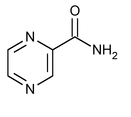Pyrazinamide
(pir'' a zin' a mide).
» Pyrazinamide contains not less than 99.0 percent and not more than 101.0 percent of C5H5N3O, calculated on the anhydrous basis.
Packaging and storage—
Preserve in well-closed containers.
Identification—
Solution:
10 µg per mL.
Medium:
water.
Absorptivities at 268 nm, calculated on the dried basis, do not differ by more than 3.0%.
C:
Boil 20 mg with 5 mL of 5 N sodium hydroxide: the odor of ammonia is perceptible.
Melting range  741
741 :
between 188
:
between 188 and 191
and 191 .
.
Water, Method I  921
921 :
not more than 0.5%.
:
not more than 0.5%.
Residue on ignition  281
281 :
not more than 0.1%.
:
not more than 0.1%.
Heavy metals, Method II  231
231 :
0.001%.
:
0.001%.
Assay—
Place about 300 mg of Pyrazinamide, accurately weighed, in a 500-mL Kjeldahl flask, dissolve in 100 mL of water, and add 75 mL of 5 N sodium hydroxide. Connect the flask by means of a distillation trap to a well-cooled condenser, the delivery tube of which dips into 20 mL of boric acid solution (1 in 25) contained in a suitable receiver. Boil gently for 20 minutes, avoiding insofar as possible distilling any of the liquid, then boil vigorously to complete the distillation of the ammonia. Cool the liquid in the receiver if necessary, add methyl purple TS, and titrate with 0.1 N hydrochloric acid VS. Perform a blank determination, and make any necessary correction. Each mL of 0.1 N hydrochloric acid is equivalent to 12.31 mg of C5H5N3O.
Auxiliary Information—
Please check for your question in the FAQs before contacting USP.
| Topic/Question | Contact | Expert Committee |
|---|---|---|
| Monograph | Leonel M. Santos, Ph.D.
Senior Scientific Liaison 1-301-816-8168 |
(SM12010) Monographs - Small Molecules 1 |
| Reference Standards | RS Technical Services 1-301-816-8129 rstech@usp.org |
USP35–NF30 Page 4488

